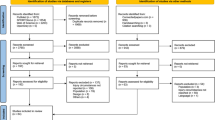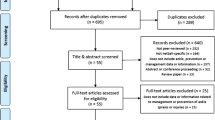Abstract
Football codes (rugby union, soccer, American football) train and play matches on natural and artificial turfs. A review of injuries on different turfs was needed to inform practitioners and sporting bodies on turf-related injury mechanisms and risk factors. Therefore, the aim of this review was to compare the incidence, nature and mechanisms of injuries sustained on newer generation artificial turfs and natural turfs. Electronic databases were searched using the keywords ‘artificial turf’, ‘natural turf’, ‘grass’ and ‘inj*’. Delimitation of 120 articles sourced to those addressing injuries in football codes and those using third and fourth generation artificial turfs or natural turfs resulted in 11 experimental papers. These 11 papers provided 20 cohorts that could be assessed using magnitude-based inferences for injury incidence rate ratio calculations pertaining to differences between surfaces. Analysis showed that 16 of the 20 cohorts showed trivial effects for overall incidence rate ratios between surfaces. There was increased risk of ankle injury playing on artificial turf in eight cohorts, with incidence rate ratios from 0.7 to 5.2. Evidence concerning risk of knee injuries on the two surfaces was inconsistent, with incidence rate ratios from 0.4 to 2.8. Two cohorts showed beneficial inferences over the 90% likelihood value for effects of artificial surface on muscle injuries for soccer players; however, there were also two harmful, four unclear and five trivial inferences across the three football codes. Inferences relating to injury severity were inconsistent, with the exception that artificial turf was very likely to have harmful effects for minor injuries in rugby union training and severe injuries in young female soccer players. No clear differences between surfaces were evident in relation to training versus match injuries. Potential mechanisms for differing injury patterns on artificial turf compared with natural turf include increased peak torque and rotational stiffness properties of shoe-surface interfaces, decreased impact attenuation properties of surfaces, differing foot loading patterns and detrimental physiological responses. Changing between surfaces may be a precursor for injury in soccer. In conclusion, studies have provided strong evidence for comparable rates of injury between new generation artificial turfs and natural turfs. An exception is the likely increased risk of ankle injury on third and fourth generation artificial turfs. Therefore, ankle injury prevention strategies must be a priority for athletes who play on artificial turf regularly. Clarification of effects of artificial surfaces on muscle and knee injuries are required given inconsistencies in incidence rate ratios depending on the football code, athlete, gender or match versus training.









Similar content being viewed by others
References
Ekstrand J, Nigg BM. Surface-related injuries in soccer. Sport Med 1989; 8 (1): 56–62
Girard O, Eicher F, Fourchet F, et al. Effects of the playing surface on plantar pressures and potential injuries in tennis. Brit J Sport Med 2007; 41 (11): 733–8
Jamison S, Lee C. The incidence of female injuries on grass and synthetic playing surfaces. Aust J Sci Med Sport 1989; 21 (2): 15–7
Pasanen K, Parkkari J, Rossi L, et al. Artificial playing surface increases the injury risk in pivoting indoor sports: aprospective one-season follow-up study in Finnish femalefloorball. Brit J Sport Med 2008; 42 (3): 194–7
Steele JR, Milburn PD. Effect of different synthetic sport surfaces on ground reaction forces at landing in netball. IntJ Sport Biomech 1988; 4 (2): 130–45
Stiles VH, James IT, Dixon SJ, et al. Natural turf surfaces. Sport Med 2009; 39 (1): 65–84
Aoki H, Kohno T, Fujiya H, et al. Incidence of injury among adolescent soccer players: a comparative study ofartificial and natural grass turfs. Clin J Sport Med 2010; 20 (1): 1–7
Dragoo JL, Braun HJ. The effect of playing surface on injury rate a review of the current literature. Sport Med 2010; 40 (11): 981–90
Higgins JPT, Green S, editors. Cochrane handbook for systematic reviews of interventions 4.2.6 [updated September 2006]. In: The Cochrane Library, issue 4, 2006. Chichester, UK: John Wiley & Sons, Ltd
Batterham AM, Hopkins WG. Making meaningful inferences about magnitudes. IJSPP 2006; 1 (1): 50–7
Meyers MC. Incidence, mechanisms, and severity of gamerelated college football injuries on Field Turf versus natural grass: a 3-year prospective study. Am J Sports Med 2010; 38 (4): 687–97
Hershman EB, Powell J, Bergfeld JA, et al. American professional football games played on FieldTurf have higherlower extremity injury rates [abstract no. 692]. Presented atthe 2010 Annual Meeting of the American Academy of Orthopaedic Surgeons; 2010 Mar 9-13; New Orleans (LA)
Ekstrand J, Hagglund M, Fuller CW. Comparison of injuries sustained on artificial turf and grass by male andfemale elite football players. Scand J Med Sci Sports. Epub 2010 Apr 28
Soligard T, Bahr R, Andersen TE. Injury risk on artificial turf and grass in youth tournament football. Scand J Med Sci Sports. Epub 2010 Aug 24
Steffen K, Andersen TE, Bahr R. Risk of injury on artificial turf and natural grass in young female football players. Brit J Sport Med 2007; 41 (1 Suppl.): i33–7
Bjorneboe J, Bahr R, Andersen TE. Risk of injury on thirdgeneration artificial turf in Norwegian professional football. Brit J Sport Med 2010; 44 (11): 794–8
Fuller CW, Dick RW, Corlette J, et al. Comparison of the incidence, nature and cause of injuries sustained on grassand new generation artificial turf by male and femalefootball players. Part 1: match injuries. Brit J Sport Med 2007; 41 (1 Suppl.): i20–6
Ekstrand J, Timpka T, Hagglund M. Risk of injury in elite football played on artificial turf versus natural grass: aprospective two-cohort study. Brit J Sport Med 2006; 40 (12): 975–80
Fuller CW, Dick RW, Corlette J, et al. Comparison of the incidence, nature and cause of injuries sustained on grassand new generation artificial turf by male and femalefootball players. Part 2: training injuries. Brit J Sport Med 2007; 41 (1 Suppl.): i27–32
Meyers MC, Barnhill BS. Incidence, causes, and severity of high school football injuries on Field Turf versus naturalgrass: a 5-year prospective study. Am J Sports Med 2004; 32 (7): 1626–38
Fuller CW, Clarke L, Molloy MG. Risk of injury associated with rugby union played on artificial turf. J Sport Sci 2010; 28 (5): 563–70
Hopkins WG. Linear models and effect magnitudes for research, clinical and practical applications. Sportscience 2010; 14: 49–57
Hopkins WG. Progressive statistics updated. Sportscience 2009; 13: 13–4
Hopkins WG. A spreadsheet for combining outcomes from several subject groups. Sportscience 2006; 10: 51–3
Hopkins WG. A spreadsheet for deriving a confidence interval, mechanistic inference and clinical inference for ap-value. Sportscience 2007; 11: 16–20
Orchard J. Is there a relationship between ground and climatic conditions and injuries in football? Sport Med 2002; 32 (7): 419–32
Lees A, Nolan L. The biomechanics of soccer: a review. J Sport Sci 1998; 16 (3): 211–34
Wright JM, Webner D. Playing field issues in sports medicine. Curr Sports Med Rep 2010; 9 (3): 129–33
Theobald P, Whitelegg L, Nokes LDM, et al. The predicted risk of head injury from fall-related impacts on to thirdgenerationartificial turf and grass soccer surfaces: a comparativebiomechanical analysis. Sports Biomech 2010; 9 (1): 29–37
FieldTurf. How FieldTurf synthetic turf works [online]. Available from URL: http://www.fieldturf.us/artificialturf-how-fieldturf-works/ [Accessed 2011 Feb 16]
FIFA. Quality concept: handbook of requirements for football turfs. Geneva: Fédération Internationale de Football Association, 2006
Ford KR, Manson NA, Evans BJ, et al. Comparison of inshoe foot loading patterns on natural grass and syntheticturf. J Sci Med Sport 2006; 9 (6): 433–40
Whiting WC, Zernicke RF. Biomechanics of musculoskeletal injury. Champaign (IL): Human Kinetics, 1998
Bahr R, Krosshaug T. Understanding injury mechanisms: a key component of preventing injuries in sport. Brit J Sport Med 2005; 39: 324–9
Villwock MR, Meyer EG, Powell JW, et al. Football playing surface and shoe design affect rotational traction. Am J Sports Med 2009; 37 (3): 518–25
Bonstinglu RW, Morehouse CA, Niebel BW. Torques developed by different types of shoes on various playing surfaces. Med Sci Sport Exercise 1975; 7 (2): 127–31
Lambson RB, Barnhill BS, Higgins RW. Football cleat design and its effect on anterior cruciate ligament injuries: a three-year prospective study. Am J Sports Med 1996; 24 (2): 155–9
Nigg BM, Yeadon MR. Biomechanical aspects of playing surfaces. J Sport Sci 1987; 5 (2): 117–45
Torg JS, Quedenfeld TC, Landau S. Shoe-surface interface and its relationship to football knee injuries. Am J Sports Med 1974; 2 (5): 261–9
Olsen O, Myklebust G, Engebretsen L, et al. Relationship between floor type and risk of ACL injury in team handball. Scand J Med Sci Sports 2003; 13 (5): 299–304
Livesay GA, Reda DR, Nauman EA. Peak torque and rotational stiffness developed at the shoe-surface interface: the effect of shoe type and playing surface. Am J Sports Med 2006; 34 (3): 415–22
Perez-Soriano P, Llana-Belloch S, Cortell-Tormo JM, et al. Biomechanical factors to be taken into account to prevent injuries and improve sporting performance on artificial turf. J Hum Sport Exerc 2009; 4 (2): 78–92
Di Michele R, Di Renzo AM, Ammazzalorso S, et al. Comparison of physiological responses to an incremental running test on treadmill, natural grass, and synthetic turf in young soccer players. J Strength Cond Res 2009; 23 (3): 939–45
Small K, McNaughton L, Greig M, et al. The effects of multidirectional soccer-specific fatigue on markers of hamstring injury risk. J Sci Med Sport 2010; 13 (1): 120–5
Andersson H, Ekblom BR, Krustrup P. Elite football on artificial turf versus natural grass: movement patterns, technical standards, and player impressions. J Sport Sci 2008; 26 (2): 113–22
Orchard JW, Powell JW. Risk of knee and ankle sprains under various weather conditions in American football. Med Sci Sport Exercise 2003; 35 (7): 1118–23
Ekstrand J, Gillquist J. Soccer injuries and their mechanisms: a prospective study. Med Sci Sport Exercise 1983; 15 (3): 267–70
FIFA. The 11+ [online]. Available from URL: http://www.fifa.com/aboutfifa/developing/medical/the11/index.html [Accessed 2011 Feb 16]
Phillips LH. Sports injury incidence. Brit J Sport Med 2000; 34 (2): 133–6
Acknowledgements
Auckland University of Technology funded this review. The authors have no conflicts of interest relevant to the content of this review. We thank Kelly Sheerin from the Sports Performance Research Institute New Zealand Running Mechanics Clinic for reviewing this manuscript.
There are no competing interests by the authors. The corresponding author has the right to grant on behalf of all authors, and does grant on behalf of all authors, an exclusive license (or nonexclusive for government employees) on a worldwide basis to the journal editor to permit this article to be published in the journal.
Author information
Authors and Affiliations
Corresponding author
Rights and permissions
About this article
Cite this article
Williams, S., Hume, P.A. & Kara, S. A Review of Football Injuries on Third and Fourth Generation Artificial Turfs Compared with Natural Turf. Sports Med 41, 903–923 (2011). https://doi.org/10.2165/11593190-000000000-00000
Published:
Issue Date:
DOI: https://doi.org/10.2165/11593190-000000000-00000




